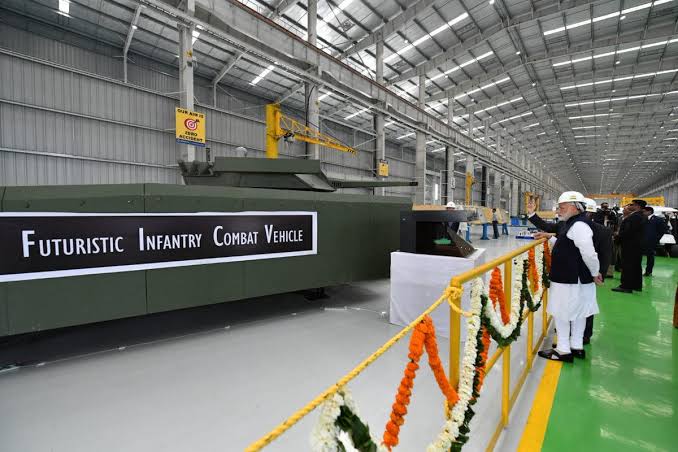Amid escalating tensions with China and persistent confrontation with Pakistan, the Indian Army is looking to procure 1,750 futuristic infantry combat vehicles (FICVs) under the Modi government’s ‘Make in India’ initiative.
Earlier this month, the Army announced its intention of buying 1,770 advanced main battle tanks, officially called future-ready combat vehicles (FRCVs).
On June 24, the Army issued a Request for Information (RFI) for the supply of the FICVs within two years after the signing of the contract.
The Army is seeking FICVs equipped with state of art weapons, which can also transport military personnel rapidly.
India-China Row: Indian Army Starts Hunt For Stealthy, AI-Enabled, Next-Gen Tanks
According to the latest RFI, the tracked FICVs should be able to move across terrains with the capability to perform amphibious operations. These vehicles would be deployed in border areas with Pakistan and China, along the deserts, plains and rough terrains, including mountains and high-altitude areas, up to 5,000 meters.
The FICV should provide “protected mobility” to its crew and the troops in diverse terrains and environments, including chemical, biological, radiological and nuclear (CBRN) ones.

The RFI clearly outlines the capabilities that Army is seeking in FICVs. It said these vehicles should be able to destroy enemy tanks, armored personnel carriers, low flying helicopters, and weapon platforms and positions on the ground.
Further, the FICV is expected to have an operational life of at least 32 years with one overhaul and repair intervention. It must also be transportable by existing tank transport vehicles of the army, the transport carriers of the Indian Air Force, and the broad-gauge military railway bogies.
The June 1 RFI sought responses from foreign armament companies or OEMs (original equipment manufacturers) for the induction of 1,770 FRCVs under the ‘Make in India’ project.

The Global RFI mentions that the Army is keen to induct the FRCVs through the “strategic partnership” route with technology transfer comprising detailed design-manufacturing know-how to the Indian partner. The Army expects to induct the FRCVs by 2030 which will then be in service as the main battle tank of the Indian Army for the next 40-50 years.
Taking into account the “emerging future threat spectrum and technological advancements”, the new FRCVs must be technologically superior and capable of operating in diverse terrains, such as high-altitude areas, plains, riverine and deserts, the RFI said.
India Looking For Advanced Tanks
In February, the Defence Ministry issued its preliminary approval for the acquisition of 118 improvised Arjun Mark-1A tanks for Rs 8,379 crore.
Will India Dare To Buy Russian T-14 Armata Tanks With Mounting US Pressure?
These 118 tanks would be added to the fleet 124 tanks which were inducted by the Indian Army almost a decade ago. It is reported that the Army initially expressed its reluctance to induct the “extra heavy” Arjun tanks and cited “maintenance and spare issues”.
I congratulate the entire team of Larsen & Toubro for building the state-of-the-art K-9 Vajra Self Propelled Howitzer.
This is a significant contribution towards India’s defence sector and protecting the country. pic.twitter.com/9YLRjHYdFE
— Narendra Modi (@narendramodi) January 19, 2019
Currently, the armored regiments of the army depend on the Russian-origin T-90 tanks. It has inducted 1,200 of the 1,657 T-90s tanks being manufactured at the Heavy Vehicles Factory, Avadi.
The army intends to replace the older T-72 tanks with state-of-the-art FRCVs. According to the army, the FRCVs will be inducted in phases so that requisite upgrades can be done in tandem with the technological advancements in warfare.
With the prime capability to destroy enemy tanks, the army wants FRCVs to have advanced features “to negate ISR (intelligence, surveillance and reconnaissance), as well as counter new aerial threats such as UCAVs (unmanned combat aerial vehicles), loitering munitions etc,” the first RFI stated.
Further, these FRCVs could be equipped with “multi-purpose smart munitions” and with gun tube-launched anti-tank guided missiles.
Delayed Acquisitions
In October 2009, the Defence Ministry expressed its interest to acquire 2,300 FICVs. But the plan did not materialize due to bureaucratic hurdles until last year.
WATCH: One More Chinese PLA Unit Gets J-20 Stealth Fighter Jets Equipped With Homegrown Engines
In March 2020, The EurAsian Times reported that the Defence Research Development Organisation (DRDO) and Ordnance Factory Board (OFB) would jointly develop the FICVs.
The vehicle has been tentatively named Mark I, and is expected to be ready for acquisition in the next 3-5 years, according to the OFB. Its sequel, Mark II, may be ready in a decade, and most of the parts of the vehicles are expected to be manufactured in the country, except a few minor subsystems.
The FICVs are expected to be equipped with an auto-grenade launcher with a range of 1,500 meters, an anti-tank guided missile capability with an estimated range of 4000 meters, along with automatic command and a gun control system which will be linked with a thermal imager fire control.
The Indian army is looking to induct the FICVs as soon as possible to counter the increasing threat from Pakistan and China, which are believed to be enhancing their own border infrastructures.
READ MORE
- Watch: The Ultimate Dogfight Between US & Russian Fighter Jets Over A ‘Top-Secret’ Air Base In Nevada
- Why India’s Ladakh Region Is Crucial For China’s Rise As An Economic Super-Power?
- 30 Times Faster Than Speed Of Sound: Is China Really Winning The Hypersonic Race With Its JF-22 Wind Tunnel?




